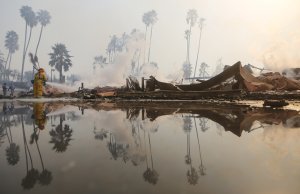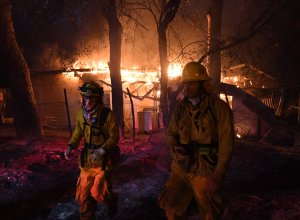The largest wildfire on record in California, the Thomas Fire, reached full containment on Friday more than a month after it began schorching homes and hillsides across Ventura and Santa Barbara counties. But the coastal communities scarred by the fierce inferno are continuing to grapple with its aftermath.

The blaze charred a total of 281,893 acres, or about 440 square miles, and claimed at least two lives after breaking out in the early morning hours of Dec. 4, according to Cal Fire.
Among the dead are a firefighter, Cory Iverson, who became trapped while battling spot fires. Virginia Pesola, a 70-year-old woman who lived in Santa Paula, was found deceased in her car along an evacuation route.
But the wildfire is also connected to the deaths of 17 people who perished in Santa Barbara County after some of the hillsides charred in the fire lost their ecological stability and gave way to mudslides during Southern California’s first major storm of the season on Tuesday.
Several people were still reported missing Friday as officials attempted to dig out the sludge, and the 101 Freeway, which had become a river of silt through Santa Barbra, remains partially closed.
The natural disasters took a large toll on homes in the area, as well. Around 1,050 structures were destroyed in the fire, and another 65 were lost in the ensuing mudslides. Hundreds more sustained significant damage. The fire is considered to be the seventh most destructive in the state’s history.
In the wildfire’s final days, only 13 firefighters were assigned to the incident as resources were redirected to the catastrophic flooding, according to officials with the Los Padres National Forest, who led the incident response after Dec. 30.
At that point, most the flames had been pushed into steep, remote areas well within the fire’s interior, firefighters said.
Before the storm hit, on Sunday, the fire had stood at 92 percent containment for more than a week. In late December, despite a drop in temperatures, containment on the stubborn blaze had only been inching up; on Christmas Day, it was at 86 percent.
The fire grew to its astounding size amid red flag warnings and low humidity that followed a particularly dry fall. When Tuesday’s rain hit, it was the first time Southern California had seen significant rainfall in nearly a year.

Fanned by powerful, sustaining Santa Ana winds and fueled by dry chaparral reaching 6 feet high, the blaze was able to spread quickly and was difficult to contain.
After breaking out near Santa Paula, the flames spread to cover the area west of Highway 126, stretching from Ventura up to Fillmore; eventually, they covered the coastal 101 Freeway corridor through La Conchita, the hillsides behind Carpinteria, Montecito and Santa Barbara, and large swaths of Los Padres National Forest on both sides of Highway 33. Parts of Ojai were left unscathed but completely surrounded, an eye in the fire’s perimeter.
Now, with the brush removed from mountainsides, the area will be at risk to flash flooding until the vegetation returns, which can take up to five years, according to forest officials.
It’s still unclear exactly how much state and federal money will need to be allocated to the firefight. At the end of December, it carried a $170-million price tag. Those costs fall on the heels of the devastating fires that hit Northern California in September, one of which is considered the most destructive in the state’s history.
But Gov. Jerry Brown says the state should be prepared for more such catastrophic incidents, calling them “the new normal” amid a changing climate during an early December press conference in Ventura.
Until Jan. 22, Ventura County residents can apply to have local officials provide free cleanup of burned homes, according to the Ventura County Star.
Some parts of the Los Padres National Forest will remain closed to the public while officials complete assessment to ensure conditions are safe.
Officials are still investigating what caused the violent inferno to break out in the first place.
#ThomasFire [final] north of Santa Paula (Ventura and Santa Barbara County) per @LosPadresNF is now 100% contained at 281,893 acres. https://t.co/y0Mk3zmzH8 pic.twitter.com/6LyjWKpcAy
— CAL FIRE (@CAL_FIRE) January 12, 2018





















